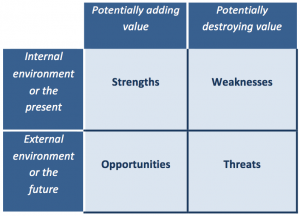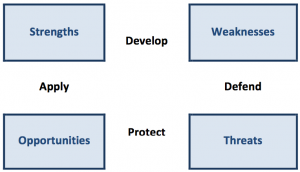Abstract
The SWOT analysis is a familiar technique used for business analysis; also known as the SWOT matrix it is a simple approach to discover the position of the business within its environment.
Most people stop the analysis after completing the four quadrants, but there is more to be discovered and realised from the analysis.
This paper explores the original ideas of classification and prioritisation, and also introduces a new direction consisting of the development of an action plan by exploring the relationships between the four quadrants.
This is probably the first original development of the technique since its introduction over 50 years ago.
Introduction
A SWOT analysis is a popular management tool that is based on a scan of the internal and external environments looking for Strengths, Weaknesses, Opportunities and Threats. The analysis is commonly presented in four quadrants, and is sometimes referred to as a SWOT matrix.
The concept was originally developed in the mid-sixties by a research team formed by Robert Stewart, Marion Dosher, Otis Benepe, Birger Lie, and Albert Humphrey (Humphrey 2005).
The original version of the tool asked the following questions:
- What’s good and bad about the operation?
- What is good and bad about the present and the future
What is good in the present is Satisfactory, good in the future is an Opportunity; bad in the present is a Fault, and bad in the future is a Threat. The original acronym S-O-F-T was later changed to SWOT, changing the focus from performance (Satisfactory) to advantages (Strengths), and defects (Faults) to disadvantages (Weaknesses).
Following the analysis step, the issues are sorted into six planning categories:
- Product
- Process
- Customer
- Distribution
- Finance
- Administration
By sorting the SWOT issues into the six planning categories it is possible to outline short and long-term priorities. This approach captures the agreement and commitment of those who are responsible and accountable for the areas under review.
Development of an Action Plan
Although having a prioritised list of issues is a good step forward, the real value of the SWOT analysis comes from the development of an Action Plan to manage the issues. This extra step is quite easy to perform, but it is not commonly done (Hill 1997).
Once all the issues have been identified, classified and prioritised, an action plan can be developed by examining the relationships between each of the four quadrants:
- Develop
Weaknesses can be mitigated by developing counter balancing strengths. For each weakness there may be a potential strength, and the objective of the action plan is to develop ways in which the identified weaknesses can be transformed into strengths. - Apply
Strengths are applied to opportunities to obtain benefits. If it is perceived that an opportunity cannot be attained because of lack of strengths, then the lack of strengths represents a weakness that needs to be addressed. - Protect
Threats can be removed using strengths and opportunities. This is a risk mitigation strategy that can be an effective start to a risk management plan. If there are no strengths or opportunities available to remove a particular threat, this represents a weakness that needs to be addressed. - Defend
Weaknesses must be defended from threats before they can be neutralised or removed. Threats should be considered as potential risks and should be identified and fully analysed.
There are two other relationships across the diagonals:
- Remove
Remove threats by applying the strengths, and develop specific strengths to target threats. - Strengthen
Weak areas must be strengthen to be able to realise the opportunities.
These strategies can be used to take the simple SWOT analysis to the next level and transform a list of issues into an effective action plan.
A practical way to organise this information is in a table with the rows showing each of the six relationships and the columns the classification categories, noting that not all boxes need to be filled in. Although the original six classifications provide a useful analysis, other groups can be used if they are more appropriate for a particular business environment. Some examples are Development, Resources, Services, Markets, and Operations.
Benefits of SWOT analysis
The main advantage of conducting a SWOT analysis is its low impact in terms of time and cost. Another advantage of a SWOT analysis is that it focuses on the most important factors affecting the business. Performing a SWOT analysis it is possible to:
- Develop business goals and strategies, and action plans for achieving the business goals
- Gain a better understanding of the business drivers and risks
- Take active steps to address real and potential weaknesses
- Protect and defend against threats
- Identify and take full advantage of opportunities
- Make the most of the business strengths
Limitations of SWOT analysis
There are many other factors that affect a business, and a SWOT analysis provides only a limited view of issues as identified by a group or taskforce. The views and recommendations made during the analysis are limited to the experience and scope of the participants, therefore it should always be validated with other members of the organisation.
Although the SWOT analysis provides an insight into development areas and risk analysis it is not a replacement of a proper risk and development needs analysis. There are other tools and frameworks that deal with eah of these subjects at length and with proper rigor.
The SWOT analysis tends to divide the world into certainty areas, but many issues exhibit multiple characteristics, a strength may also have weaknesses or pose threats, so the analysis should always consider the multiple nature of each item and make the necessary balancing entries in the matrix.
Conclusion
The SWOT analysis is a popular technique because it is simple and direct. Most people limit themselves to identify the four categories of items and fail to progress the analysis further. In its original form the analysis progressed to a classification of the items into six groups and it then prioritised each item within the groups but that step is rarely performed.
A further development of the technique consists of the exploration of the relationships between the four quadrants resulting in six strategies that can identify specific actions.
The outcome of a SWOT analysis should be an agreed action plan with specific outcomes and responsibilities. Progress of these actions should be monitored until successfully completed.
References
Albert S. Humphrey, A. S. SRI International (2005). “SWOT Analysis for Management Consulting”.
Hill, T. & R. Westbrook (1997). “SWOT Analysis: It’s Time for a Product Recall”.



